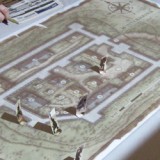Introducing Sandbox VR
In the Beginning
Virtual Reality has proven to be a strong competitor for your entertainment dollars. In the last few years, both home and destination VR experiences blow away the kitschy, low resolution, heavy, and limiting technology of the late 80s and 90s. I still remember my first foray into virtual space: a Cutty Sark sponsored trip on a pirate galleon. This was probably 30 years ago, and was underwhelming to say the least. It still made an impression. Thanks to Sandbox VR, a newcomer to the location-based VR market who recently secured a boatload of celebrity funding (Techcrunch), Media Geeks was treated to a much improved pirate expedition (and more), untethered and impressive, if still a little flawed.
The Geeks here are all in agreement when it comes to VR: The Void is the place to beat right now. Their tech and attention to detail in the immersive-verse, not to mention the high profile franchises they’ve partnered with (Ghostbusters, Marvel’s Avengers, Star Wars) make for a high bar of competition. Sandbox VR will soon be sporting their own major sci-fi tie-in however with Star Trek Away Mission. That’s still a few months away, and we’ll be doing a write up when it becomes available, but for now, there are 3 adventures to set your sights on. We were treated to two.
Amber Sky 2088
Our first appointment was for a futuristic sci-fi story, Sandbox’s newest experience (at the time). The sparsely decorated lobby seemed low on staff too, and we weren’t sure what to do. A few minutes late, someone brought us motion trackers to put on our hands and feet, then led us into the room. It was empty, with green walls and a rack of equipment on one side. The vests and backpack computers were very familiar, but there is an unusual drawback with the headset. It does not accommodate glasses. I can’t remember encountering this limitation before. They have lenses to fit inside the headset to replicate your glasses, but they don’t have a way of correlating them to your prescription. So the process was trial and error. Hold lenses up to your eyes, see if they are clear enough, try the next pair, and the next, until you find one that you can live with, but still isn’t as good as your own prescription. It’s a minor nuisance more than a major one, but it’s one I don’t understand. I’ve used a variety of headsets over my glasses with no problem. I would recommend wearing contacts to anyone who has the option.
Once inside the virtual world, there was some customization of your avatar. This is an area where they have an edge over The Void and Dreamscape. Those let you choose what your avatar looks like, but it’s just a skin. Sandbox provides different functionality to your robotic guardians in Amber Sky 2088. Two of us got to be defenders, with an energy shield that would generate when you made a certain hand gesture, as well as the ability to throw it into enemies like Captain America. The other two had a different color scheme and were more focused on offense, with a bigger, flame-throwing gun compared to the defenders’ pistol. I like the variety offered here and it’s one of the best selling points of Sandbox. We then got a bit of practice with the weapons, using targets appearing in the space around us before the story began.
The setup for the scenario is pretty cool. We’re on a space elevator, one of many around the world, but Earth is under attack. The other elevators have been destroyed and we’re guarding mankind’s last hope as we rise from the city up to low orbit where an anchored space station waits. There are characters and dialogue, but unfortunately they are hard to hear. Most of this was due to hearing my teammates’ chatter through their microphones. It’s a neat feature to hear your friends clearly, but it’s a drawback when they’re drowning out the story you want to listen to. I wonder if Sandbox can find a way to mute the microphones during story dialogue.
The game itself is purely a shooter. Waves of aliens and spaceships swarm our platform, which rises, falls, and separates. You’re constantly looking for the next target, which doesn’t leave a lot of time to soak in the gorgeous visuals. If you sustain too much damage, you are incapacitated, but there’s a healing mechanism built in to encourage teamwork with others. And if your whole group is knocked out with nobody left to heal you? Well, then you just get a group respawn after a few seconds. It’s very fast-paced, with only short breaks between attacks. There are a variety of enemies, some falling to a single shot, some requiring multiple strikes and concentrated fire.
Like the intro, the finale has amazing sights amid its hard-to-hear denouement. As a game, it’s fun, albeit repetitive. As a story, it’s perfunctory but I still would have liked to pay more attention to it. As a technology though, we had some real struggles. My haptic vest was not functioning for the first half of the game. I didn’t even know it was supposed to vibrate until I got kicked out of the program. My friends were still zapping away, but all I saw were white walls in my headset. They had to pause the game, reset me, and start us all up again. Only then, with my vest buzzing, did I realize I hadn’t even been getting the full experience before. Additionally, the shield gesture was inconsistent. I was constantly bring my hand to my chest to create the shield. If I had to guess how often it worked, I would say 60% of the time. I don’t know what I could do to get a more consistent result, but it did leave me getting knocked out more often (and needing more healing) than I should have. These are only the in-game glitches. During the setup, we had more issues, including weapons that wouldn’t fire and shrunken avatars. Although that was all resolved before the simulation started, it did add time to the process. Because of this, it was hard to separate the fun game from the frustrating user experience.
Curse of Davy Jones
It may have been a problem specific to the room we were in because before our next adventure, the whole system essentially crashed and we were moved to the next VR pod down the hall. This one, the Curse of Davy Jones, had a story right up my alley. Our guild of globe-trotting treasure hunters has scoured the seas and finally tracked down the ultimate prize; the fabled treasure of legendary pirate Davy Jones. It resides on a cursed ship, guarded by all manner of undead minions. You get to choose your swashbuckler, select your weapon, and elect a captain before blasting your way to the bowels of the galleon to claim your reward.
Thankfully, this was a much smoother game than our Amber Sky session, which eased some assumptions about the facility and their ability to serve customers. We’ll just chalk it up to bad luck. We once again donned motion trackers, vests, the “backtop” computers and headsets. Our host booted us into a staging area similar to Amber Sky’s, but instead of faceless robot sentry avatars, we were directed to choose one of several highly detailed and super stylized pirates. Next, grab either a blunderbuss style pistol or a repeating crossbow for defense. Finally, our appointed captain received a torch to light the way. A small detail that honestly stands out strong amongst other VR experiences is that, after choosing our characters, a virtual mirror appeared that we could see ourselves in. For a few moments, we could really get the feel of being in another skin. My buccaneer had a peg leg and I just couldn’t help mimicking the staggered gait of a man with a wooden log for an appendage. Another member of our group decided to cross-dress with a female avatar. Naturally, that led to a good amount of ribald fun.
The role-play didn’t last long however. Once virtually transported to our ship, it became about aiming true, defending each other from waves of skeletal boarding parties, banshees, and foot-tall imps (which were pure joy to kick). Gameplay largely consisted of firing, reloading and repeating.
I was mildly annoyed at the occasional sensitivity issue in gunplay. Reloading is simply a matter of lowering your weapon to your hip, but the game frequently failed to recognize the motion, which left us open to attack. I feel like this is minor but could very easily be resolved by changing the mechanic to use one of the dozen buttons or switches on the gun controller that were left otherwise unused.
A mid-level boss awkwardly ceased the firing in a sort of odd Marco Polo moment and a few mild puzzle solving elements preceded a final boss encounter that would seem largely formulaic to any gamer, though it does gain a sense of scale you won’t get on ever the biggest TV. These other gameplay moments added welcome diversity to the proceedings. Instead of purely shooting, like Amber Sky, it felt like a more well-rounded experience and kept us interested in discovering what we would have to do next.
Curse of Davy Jones adds a bit of environmental ambience with the use of wall mounted fans, blowing in sync with the in-game action (blowing shutters open, banshees flying past) as well as the haptic ‘hits’ felt on our backs and chests from enemy attacks. Neither experience, however, boasted the tactile crossover of The Void as there were no real world buttons to press or levers to pull. This means that each area of the game was mostly just an open square section to pace back and forth in. Sanbox’s VR tech opts for the more traditional motion capture techniques utilized for film and television to put you in the virtual environments. The Void’s, in comparison, is more maze-like, using different tracking techniques and rarely seen by the public eye.
Deadwood Mansion
Sandbox also has a third experience, which is their original one. We didn’t try it (on account of our editor’s weak constitution) (Editor’s note: HEY! … only a little), but it’s a zombie-themed game. You have to fend off hordes of the undead, and they’re the gross kind, with exposed bones and viscera flying everywhere.
Bonus!
Unlike The Void (as of this writing) your score is kept and displayed for all to see in your debriefing after the session. I’m a sucker for competition vs cooperation and Sandbox is the first location-based VR I’ve participated in that does both in all 3 experiences. Finally, guests are given a link to videos of their experience, edited down to key moments that swaps back and forth from actual filmed sequences and video grabs on in-game action. A definite added bonus, particularly to those booking larger parties, ensuring a memorable night out that is easily shareable to the socials for bragging rights.
Real Reality
Bottom line, Sandbox VR is a solid choice for a good 30 minutes of immersive gaming and new locations are starting to pop up all over. In addition to locations in L.A., San Fran and Vancouver, Asia sports their own Sandboxes in Hong Kong, Jakarta, Macau and Singapore. Coming soon are Austin, Chicago, Dallas, New York and San Diego.
Ticket prices vary slightly, depending on peak time bookings: $32 per person during non-peak, $38 during busier times. This is a tad bit pricier when stacked against The Void’s $29.95 sticker, but use promo code MATRIX to take a chunk off when booking online. More information is available on their website.
Sandbox VR is definitely one to keep an eye on. We mentioned the Star Trek experience on its way, but they’re also introducing a new way to play, coming very soon, that we’re looking forward to: Player vs player melee combat in Unbound Fighting League – UFL. Expect more on that to come.
Ryan Davis contributed to this review. VR sessions were provided by Sandbox VR for review purposes.


















